The PT leveraged mining strategy of AAVE+Pendle+Ethena is not a risk-free arbitrage strategy, as there is still a discount rate risk associated with PT assets. Therefore, participating users need to objectively assess and control their leverage to avoid liquidation.
Written by: @Web3_Mario
Abstract: Recently, I have been quite busy with work, which has delayed updates for a while. I am now resuming weekly updates and I appreciate the support from all my friends. This week, I discovered an interesting strategy in the DeFi space that has received widespread attention and discussion, which is to use Ethena's staking yield certificate sUSDe as the source of income for Pendle's fixed yield certificate PT-sUSDe, and leverage the AAVE lending protocol as the source of funds to conduct interest rate arbitrage and obtain leveraged returns. Some DeFi KOLs on the X platform have given optimistic evaluations of this strategy, but I believe the current market seems to overlook some risks behind this strategy. Therefore, I would like to share some insights. Overall, the PT leveraged mining strategy of AAVE+Pendle+Ethena is not a risk-free arbitrage strategy, as there is still a discount rate risk associated with PT assets. Therefore, participating users need to objectively assess and control their leverage to avoid liquidation.
Analysis of PT Leveraged Returns Mechanism
First, let’s briefly introduce the mechanism of this yield strategy. Friends familiar with DeFi should know that DeFi, as a decentralized financial service, has a core advantage over TradFi by leveraging smart contracts to carry core business capabilities, which brings about the so-called "interoperability" advantage. Most DeFi experts, or DeFi Degens, typically focus on three main tasks:
- Discovering arbitrage opportunities between DeFi protocols;
- Finding sources of leveraged funds;
- Identifying high-yield, low-risk earning scenarios;
The PT leveraged yield strategy comprehensively reflects these three characteristics. This strategy involves three DeFi protocols: Ethena, Pendle, and AAVE. All three are popular projects in the current DeFi space, and I will provide a brief introduction here. First, Ethena is a yield-bearing stablecoin protocol that captures low-risk returns from the perpetual contract market in centralized exchanges through a Delta Neutral hedging strategy. During a bull market, due to the extremely strong demand from retail investors to go long, they are willing to bear higher fee costs, resulting in higher yields for this strategy, with sUSDe being its yield certificate. Pendle is a fixed-rate protocol that decomposes floating yield certificates into Principal Tokens (PT) and Yield Tokens (YT) that resemble zero-coupon bonds through synthetic assets. If investors are pessimistic about future interest rate changes, they can lock in the interest rate level for a certain period by selling YT (or buying PT). AAVE is a decentralized lending protocol where users can use specified cryptocurrencies as collateral and borrow other cryptocurrencies from AAVE to achieve effects such as increasing capital leverage, hedging, or shorting.
This strategy integrates the three protocols by using Ethena's staking yield certificate sUSDe as the source of income for Pendle's fixed yield certificate PT-sUSDe, and leveraging the AAVE lending protocol as the source of funds to conduct interest rate arbitrage and obtain leveraged returns. The specific process is as follows: first, users can obtain sUSDe from Ethena and fully exchange it for PT-sUSDe through the Pendle protocol to lock in the interest rate. Next, they deposit PT-sUSDe into AAVE as collateral and borrow USDe or other stablecoins through a looping loan method, repeating the above strategy to increase capital leverage. The yield calculation is mainly determined by three factors: the base yield rate of PT-sUSDe, the leverage multiple, and the interest rate spread in AAVE.
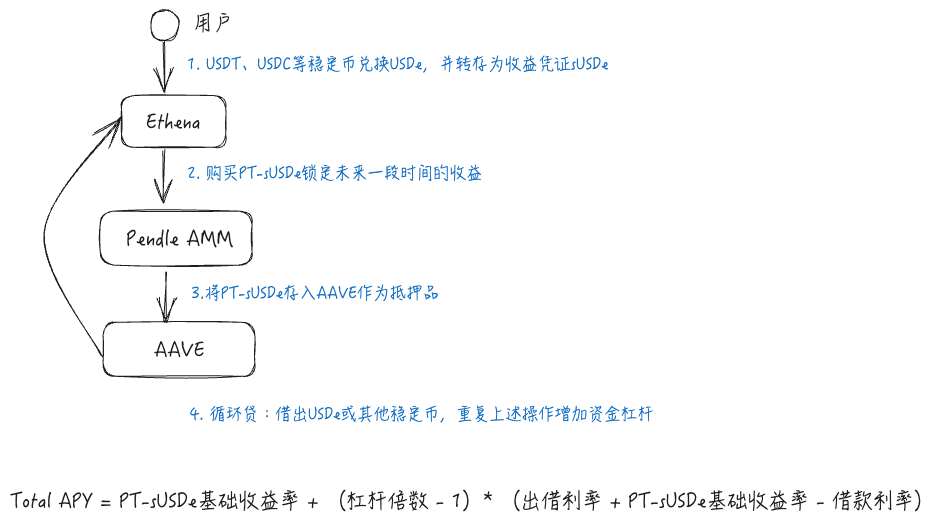
Current Market Status and User Participation in the Strategy
The popularity of this strategy can be traced back to AAVE's recognition of PT assets as collateral, which has released the financing capability of PT assets. In fact, before this, other DeFi protocols had already supported PT assets as collateral, such as Morpho and Fluid, but AAVE, with its more abundant lending funds, can offer lower borrowing rates, amplifying the yield of this strategy, and AAVE's decision carries more symbolic significance.
Since AAVE began supporting PT assets, the staked funds have rapidly increased, indicating that this strategy has gained recognition from DeFi users, especially some whale users. Currently, AAVE supports two types of PT assets: PTsUSDe July and PTeUSDe May, with a total supply reaching approximately $1B.

The maximum leverage multiple currently supported can be calculated based on its E-Mode's Max LTV. Taking PT sUSDe July as an example, the Max LTV for this asset as collateral in E-Mode is 88.9%, which means that through looping loans, the leverage can theoretically reach about 9 times. The specific calculation process is shown in the diagram below. This means that when leverage is at its maximum, not considering Gas fees or the costs of flash loans or fund exchanges brought by looping loans, the yield rate of the strategy can theoretically reach 60.79%. Moreover, this yield does not include Ethena point rewards.

Next, let’s look at the distribution of actual participants, still taking the PT-sUSDe pool on AAVE as an example. The total supply of 450M is provided by 78 investors, indicating a high proportion of whales and significant leverage.
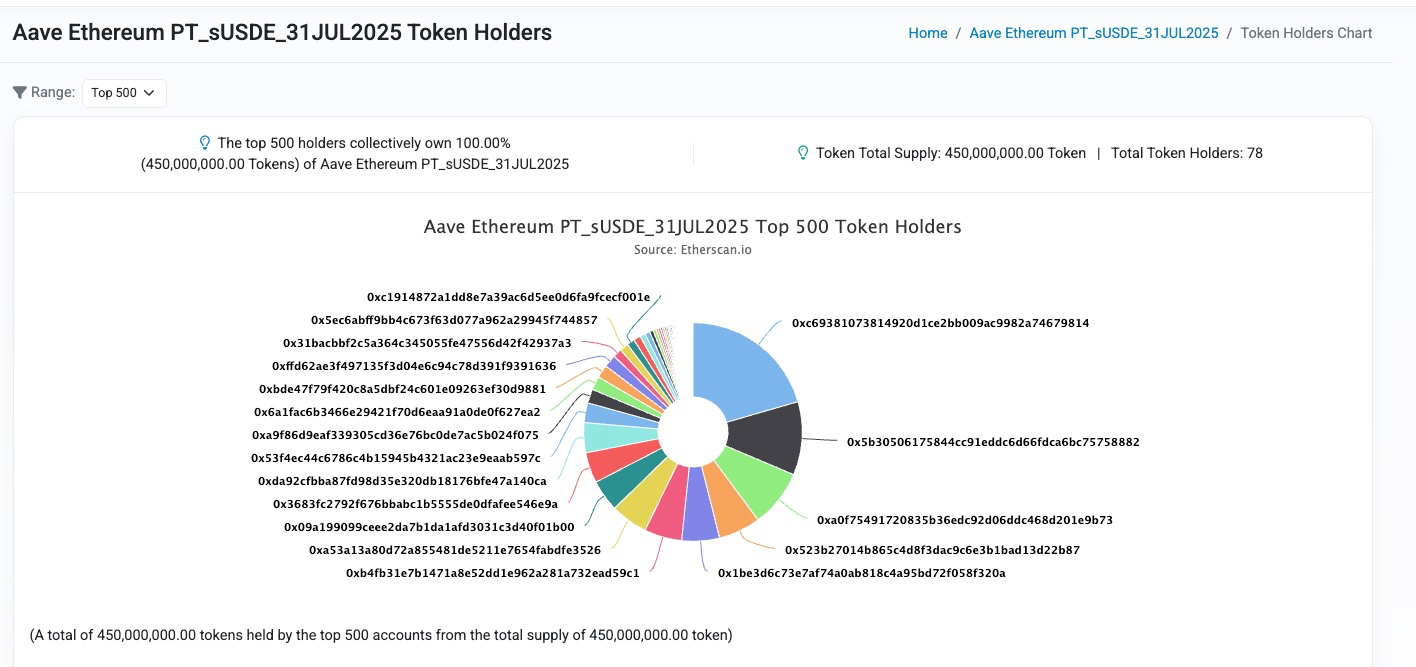
Looking at the top four addresses, the first address 0xc693…9814 has a leverage of 9 times with a principal of about 10M. The second address 0x5b305…8882 has a leverage of 6.6 times with a principal of about 7.25M, the third address analytico.eth has a leverage of 6.5 times with a principal of about 5.75M, and the fourth address 0x523b27…2b87 has a leverage of 8.35 times with a principal of about 3.29M.
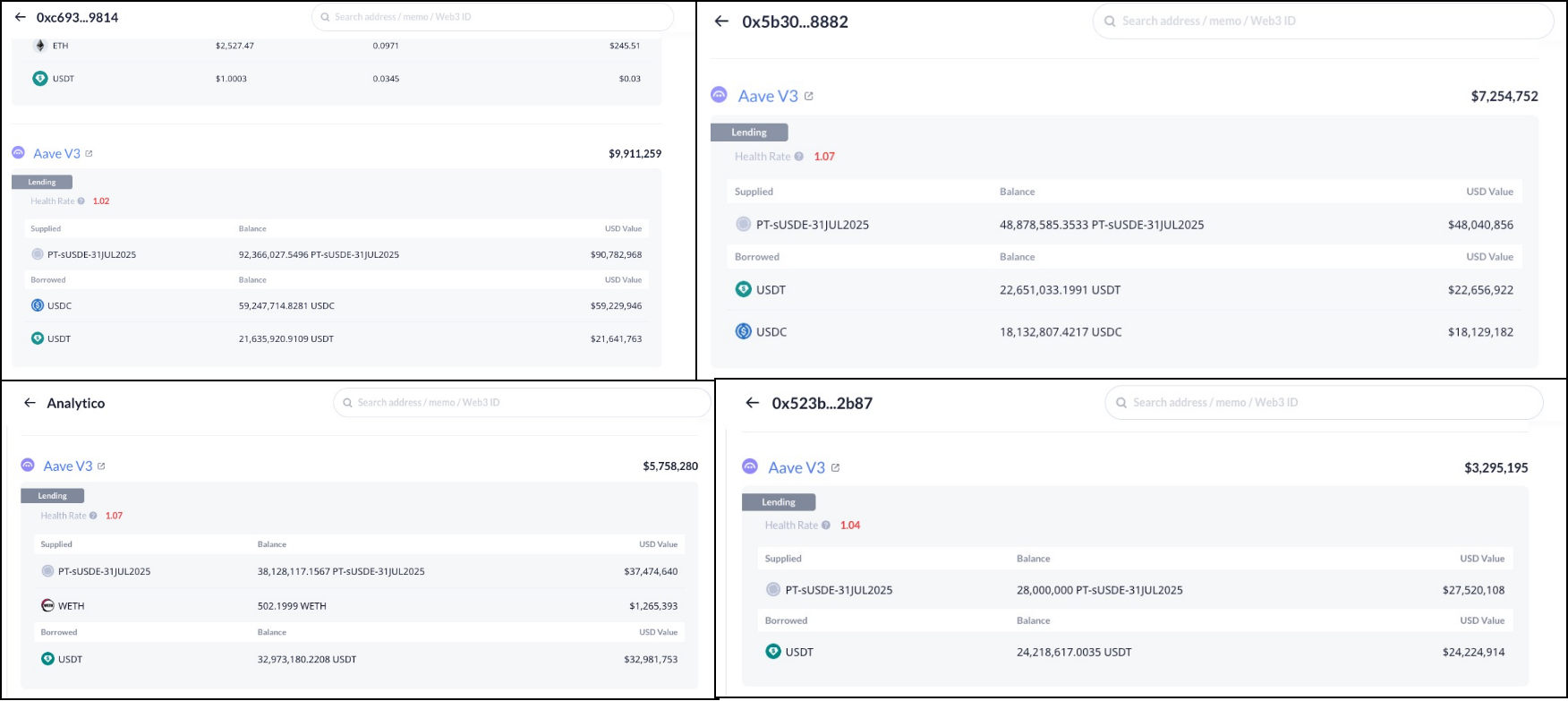
Thus, it can be seen that most investors are willing to allocate a high capital leverage for this strategy. However, I believe the market may be a bit too aggressive and optimistic. This emotional and risk perception bias could easily lead to large-scale liquidation events. Therefore, let’s analyze the risks associated with this strategy.
Discount Rate Risk Cannot Be Ignored
I have noticed that most DeFi analysis accounts emphasize the low-risk characteristics of this strategy, even branding it as a risk-free arbitrage strategy. However, this is not the case. We know that the risks of leveraged mining strategies mainly include two types:
- Exchange rate risk: When the exchange rate between the collateral and the borrowed asset decreases, there is a risk of liquidation. This is relatively easy to understand, as the collateralization ratio will decrease in this process.
- Interest rate risk: When borrowing rates increase, it may lead to an overall negative yield for the strategy.
Most analyses tend to believe that the exchange rate risk of this strategy is extremely low because USDe, as a relatively mature stablecoin protocol, has undergone market testing, and its risk of decoupling is low. Therefore, as long as the borrowed asset is a stablecoin, the exchange rate risk is low. Even if decoupling occurs, as long as the borrowed asset is USDe, the relative exchange rate will not experience a significant decline.
However, this judgment overlooks the uniqueness of PT assets. We know that the most critical function of lending protocols is to ensure timely liquidation to avoid bad debts. However, PT assets have a concept of duration. During the duration, if one wants to redeem the principal asset early, it can only be done through the AMM secondary market provided by Pendle for discount trading. Therefore, trading will affect the price of PT assets, or in other words, affect the yield rate of PT. Thus, the price of PT assets is constantly changing with trading, but the general direction will gradually approach 1.
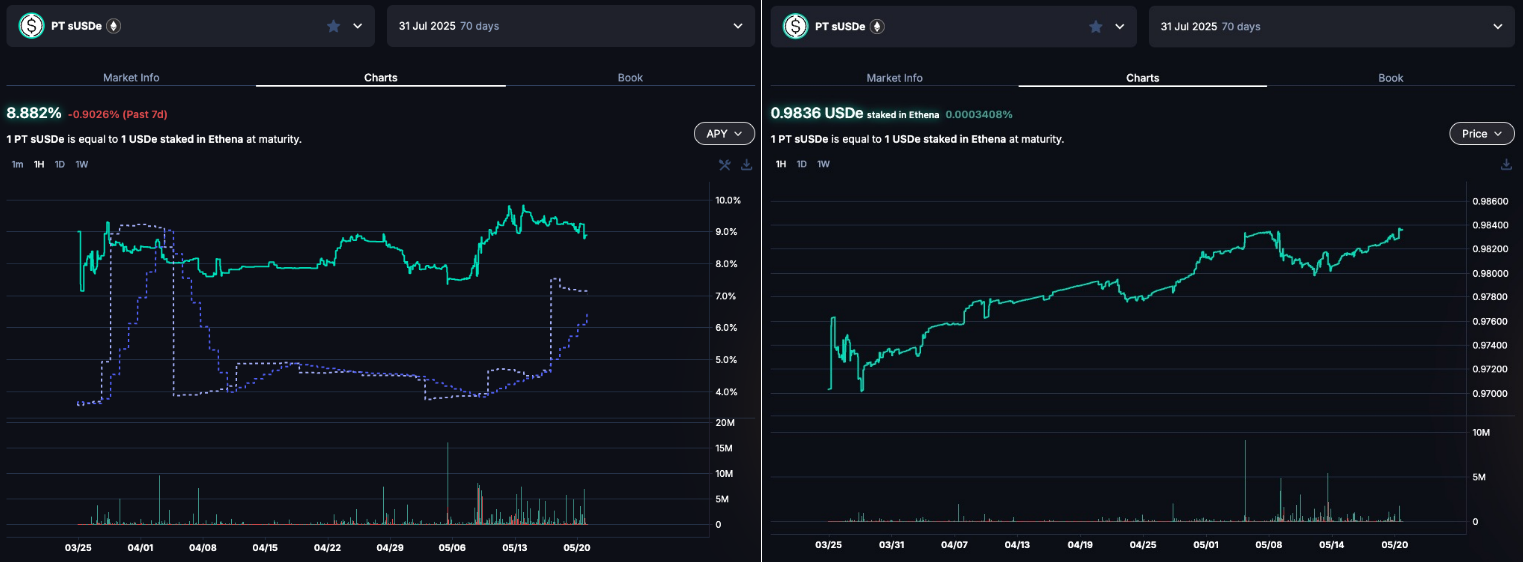
After clarifying this characteristic, let’s look at AAVE's design scheme for the price oracle of PT assets. In fact, before AAVE supported PT, this strategy mainly utilized Morpho as the source of leveraged funds. In Morpho, the price oracle for PT assets adopted a design called PendleSparkLinearDiscountOracle. Simply put, Morpho believes that during the bond's duration, PT assets will earn returns relative to the native assets at a fixed rate, ignoring the impact of market trading on interest rates. This means that the exchange rate of PT assets relative to native assets is continuously increasing linearly. Therefore, the exchange rate risk can naturally be ignored.

However, during the research process for the oracle solution for PT assets, AAVE concluded that this was not a good choice because the proposed solution locks in the yield rate and is non-adjustable during the duration of PT assets. This means that the model cannot effectively reflect the impact of market trading or changes in the underlying yield rate on the price of PT assets. If market sentiment is bullish on interest rate changes in the short term, or if there is a structural upward trend in the underlying yield rate (for example, due to a surge in incentive token prices or new yield distribution plans), it could lead to the oracle price of PT assets in Morpho being significantly higher than the actual price, which could easily result in bad debts. To mitigate this risk, Morpho typically sets a benchmark interest rate that is significantly higher than the market rate, which means Morpho actively suppresses the value of PT assets, creating a wider volatility space, but this also leads to low capital utilization.
To optimize this issue, AAVE adopted an off-chain pricing solution that allows the oracle price to follow the structural changes in PT interest rates as closely as possible while avoiding short-term market manipulation risks. We will not delve into the technical details here, as there is a dedicated discussion on this issue in AAVE's forum. Interested parties can also discuss it with me on X. Here, I will present the potential price-following effect of the PT Oracle in AAVE. It can be seen that in AAVE, the oracle price behaves similarly to a piecewise function, following market interest rates. This offers higher capital efficiency compared to Morpho's linear pricing model and better mitigates the risk of bad debts.
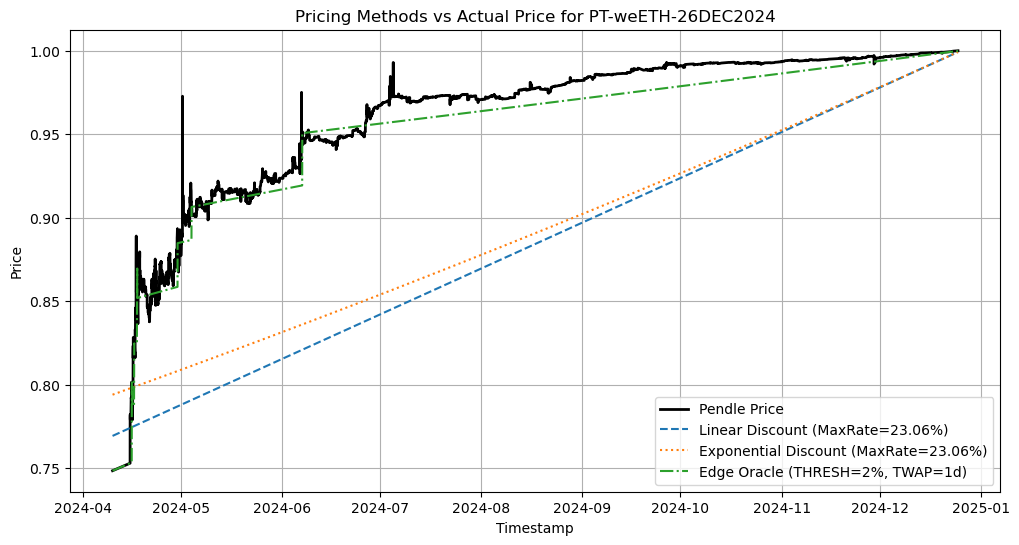
This means that if there is a structural adjustment in the interest rate of PT assets, or if the market has a consistent direction regarding interest rate changes in the short term, the AAVE Oracle will follow this change. Therefore, this introduces discount rate risk to the strategy, meaning that if the PT interest rate rises for some reason, the price of PT assets will decrease accordingly, and the high leverage of this strategy may pose a liquidation risk. Thus, we need to clarify the pricing mechanism of the AAVE Oracle for PT assets to rationally adjust leverage and effectively balance risk and return. Here are some key features to consider:
- Due to the mechanism design of Pendle AMM, liquidity will concentrate around the current interest rate over time. This means that the price changes brought about by market trading will become less and less significant, or in other words, the slippage will decrease. Therefore, as the expiration date approaches, the price changes resulting from market behavior will become smaller. In response to this characteristic, AAVE Oracle has introduced the concept of a heartbeat to indicate the frequency of price updates. The closer it gets to the expiration date, the larger the heartbeat, and the lower the update frequency, meaning that the discount rate risk is lower.
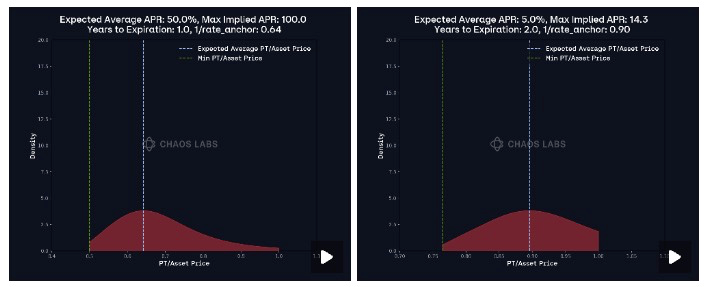
- The AAVE Oracle will consider a 1% change in interest rates as another adjustment factor for price updates. When the market interest rate deviates from the oracle rate by 1% and the deviation time exceeds the heartbeat, a price update will be triggered. This mechanism also provides a time window for timely adjustments to leverage rates to avoid liquidation. Therefore, for users of this strategy, it is essential to monitor interest rate changes and adjust leverage accordingly.
免责声明:本文章仅代表作者个人观点,不代表本平台的立场和观点。本文章仅供信息分享,不构成对任何人的任何投资建议。用户与作者之间的任何争议,与本平台无关。如网页中刊载的文章或图片涉及侵权,请提供相关的权利证明和身份证明发送邮件到support@aicoin.com,本平台相关工作人员将会进行核查。




